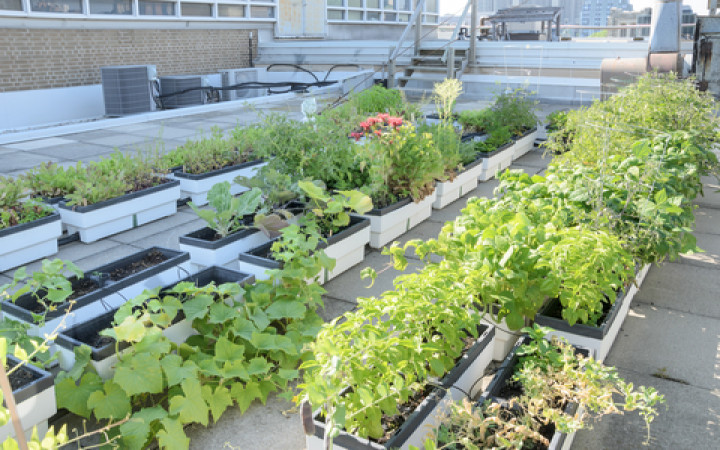Today’s Wonder of the Day was inspired by Heather. Heather Wonders, “What do gardens on rooftops in cities look like? What plants are in them to help clean the air?” Thanks for WONDERing with us, Heather!
Imagine you are touring a skyscraper in a large city like Chicago or New York. From the top floor, you look out the window. You might see birds, clouds, or even a beautiful sunset. If you look down, you could see the street and sidewalk many floors below. The cars and people would look so small!
However, you could also see trees, containers of plants, or a lush covering of vegetation growing on the roof of a nearby building. You have spied a rooftop garden! It is a home for plants on top of a human-made structure.
There are different kinds of rooftop gardens. Sometimes people will put large containers, trays, or pots on a flat rooftop. They can grow vegetables, herbs, or flowers. Tomatoes, peppers, and basil are good plants for rooftop container gardens. Other rooftop gardens are green roofs where vegetation is part of the roof system.
A green roof has several layers. One of today’s Wonder pictures illustrates them. The base is the roof, which covers the structure. Then there is waterproofing material which keeps water from leaking through the roof. Above that, there can be other protective layers. They keep plant roots from damaging the roof and help water to drain.
Then there is a layer of growing medium. Regular soil is too heavy for roofs. It is mixed with materials, like perlite, to create a special growing medium. The mixture is lighter than regular soil. It also allows water to drain better. Vegetation is planted in the growing medium. The plants are the last layer on a green roof.
There are two main types of green roofs: extensive and intensive. Extensive green roofs are simpler. A layer of short hardy plants, like grasses or succulents, cover the roof. These plants only need a few inches of growing medium. Intensive green roofs look more like a garden or park. They can have larger plants like vegetables, flowers, or even trees. They might also have park benches, beehives, or other structures within the rooftop garden.
Intensive green roofs weigh more than extensive ones. Buildings with intensive roofs need more supports to hold the weight. Extensive green roofs cost less to build since they do not need the additional supports.
You may wonder: why would a builder or architect spend extra money to install a green roof? One reason is that they are good for the planet. Green roofs use and store rainwater. It does not run into the sewage system, where water has to be purified before it can be used. Also, green roofs can help clean the air. The plants can capture pollution.
Green roofs can make cities cooler. Most traditional roofs are made of dark materials that absorb sunlight. They get very hot making the area much warmer. Additionally, cities have concrete in sidewalks and buildings and asphalt in roads and parking lots. These building materials absorb and hold heat from the sun. Cities can be two to ten degrees warmer than the surrounding areas. Scientists call this phenomenon an urban heat island.
Plants can help reduce the warming in urban heat islands. In green spaces, such as parks, rooftop container gardens, and green roofs, heat from the sun evaporates water from plants. This process is called transpiration. When there are enough plants growing in one place, transpiration cools the area.
Besides being good for the planet, rooftop gardens can have other benefits for residents and wildlife. People have spaces to grow healthy vegetables. Children have safe places to play. Birds and insects have urban habitats. Plus, rooftop gardens are beautiful!
While rooftop gardens are often associated with cities, people can create them anywhere. The rooftop just needs to be flat and strong enough to support the weight of vegetation. So be on the lookout! Are there any green roofs in your community? Do you see rooftops that could be made into green spaces?
Standards: CCRA.R.1, CCRA.R.2, CCRA.R.3, CCRA.R.10, CCRA.L.3, CCRA.L.4, CCRA.L.5, CCRA.L.6, CCRA.SL.4, CCRA.W.1, SMP.4, ESS2-1, NCAS.CR.1




